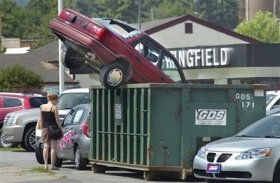
Full coverage insurance Quotes
Typically I’d be reminding you how important high liability limits are to protect you if you cause an accident that injures somebody. However, this is all about you, what you’re covered for, and what’s best for you financially when it comes to coverage. Normally you may hear nothing but “increase your insurance coverage!” from insurance professionals, but there are actually times you need to scale it back. 
When would that be? Usually when your car is old. This doesn’t mean you don’t love your car — plenty of people drive their cars until they no longer run. But old cars can be costly if you continue carrying full coverage. With older vehicles, there’s a good chance the premiums you pay are more than the value of the car.
Sometimes insurers will tell you this, either out of good faith or they’ll just outright refuse to extend full coverage. You shouldn’t wait on your insurer to tell you when enough is enough though — to ensure you’re getting the most bang for your buck, you need to figure out when it’s time to increase coverage, downgrade it, and make other needed changes. So what should you look for? Here are five questions to ask yourself when trying to decide if it’s in your best interest to keep full coverage.
What am I giving up?
If you decide to drop full coverage, understand what won’t be covered. When people refer to full coverage, what they’re really talking about is comprehensive, collision, and liability on one policy. Liability protects another person and their property if you cause an accident. Collision coverage would kick in in situations where your car is damaged in that same accident or in single-car accidents (like hitting a telephone pole). Comprehensive generally covers everything else that isn’t the result of a crash. If hail cracks your windshield or dents your hood, comprehensive covers it. If vagrant teens spray paint your car on Halloween, comprehensive will cover it.
Note this though — full coverage only refers to comprehensive and collision coverage in addition to liability. Full coverage does not automatically include extras like towing and labor, roadside assistance, rental car coverage, or other optional add-ons. If you call an insurer right now and ask for full coverage with state minimum liability limits, you’re going to get a policy with bodily injury and property damage liability, comprehensive coverage, and collision coverage — that’s all. With most insurers, you’re not even eligible for those extra coverage options unless you have “full coverage.”
Thus, “full coverage” isn’t as “full” as you may believe it to be, and when full coverage is removed, your policy will be pretty empty and only have liability coverage. That means absolutely no coverage for your vehicle at all. In addition to comprehensive and collision coverage, if you’re a fan of perks like roadside assistance, keeping full coverage may be worth it to you — just ensure you can’t get roadside assistance cheaper elsewhere. Ask yourself what’s holding you back from dropping full coverage and what you need most. The only time an insurer would pay to fix your car or ‘replace’ it is if someone else causes an accident. Then their liability coverage would cover your car.
Do I owe on the car or is there a lienholder?
One of the first things to figure out is if you’re even allowed to drop comprehensive and collision coverage. Often only seen in the case of newer vehicles that are financed, banks and lienholders will usually request that the loan owner carry full coverage until the loan terms are satisfied (until the car is paid for or until the lien is released). However, just because a car is old doesn’t mean it’s owned straight-out. If you still owe on your car, this is an easy decision because there’s a 99% chance that you don’t have a decision to make. You’re required to have comprehensive and collision on any car you still make payments on or that you’ve used as collateral for any kind of loan. As soon as you pay your car off or have satisfied the requirements set forth by a lienholder, then you can consider dropping full coverage.
What’s the value of my car?
Establish the value of your car to see if it’s worth it to keep full coverage or not. A car is not a fine wine — it only depreciates with age (antique and collector vehicles excluded). As it gets older, the value goes down even if it’s been well cared for.
So the value to look for? Eric Poe, CEO of CURE Auto Insurance, sets the bar at $5K. If your car’s value is less than this, it’s probably wise to drop full coverage. Use sources like Kelley Blue Book and Black Book and N.A.D.A. Guides to determine value. If you can’t find your car or believe the value is different than the listed price, you can get it appraised, but usually you can avoid that expense by being honest with yourself about your car’s condition. You may have taken your wife out on your first date in that car, but last time I checked, N.A.D.A. doesn’t include a section for sentimental value.
How much do I pay for collision coverage?
Here’s where your car’s value matters most and where you’ll need to do some math.
Look at your most recent insurance statement. You’ll notice the majority of your bill comprises collision coverage. It’s expensive, but property damage can be as well. According to National Highway Safety and Traffic Administration, the average property damage price in car accidents is right over $26K. As expected, insurers raise rates for policies covering more expensive risks. When you compare what you pay for collision insurance with your car’s actual cash value, does it add up?
If you’re paying an extra $60 a month to have full coverage, you have a $1K deductible, and your car is only worth $1, 500, it’s not economical to keep full coverage. If your car were totaled, the insurance company would only pay $500, you’d be responsible for $1K, and you would have spent $720 annually paying for full coverage. You’ve then spent a total of $1, 720 out of your own pocket. That’s almost the price of replacing your car and you’ve paid more to the insurer than you stand to get back if the car is totaled. It’s better to bank the difference.
If you’re wary of dropping full coverage, try dropping collision first. This may be easier if you’re a safe driver, and you’d still be covered in freak accidents, like if a tree falls on your car. Hey, it does happen.
















